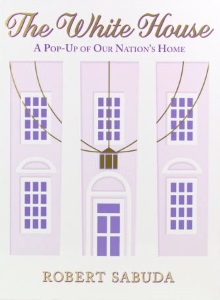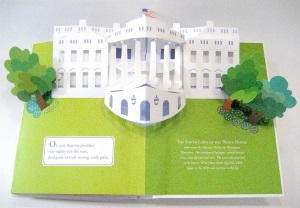2018 School Spending Survey Report

Find more great Horn Book content at these links:
Recommended books: reviews and themed booklists
App and e-book reviews
Movie reviews
Event news and recaps
Events calendar
A pop-up tour of the White House
For some reason, I've been a little preoccupied by all things presidential lately, so I was intrigued when Robert Sabuda's book The White House: A Pop-Up of Our Nation's Home (Orchard Books, January 2016) arrived in the office.
 For some reason, I've been a little preoccupied by all things presidential lately, so I was intrigued when Robert Sabuda's book The White House: A Pop-Up of Our Nation's Home (Orchard Books, January 2016) arrived in the office. Sabuda is best known for his pop-up versions of children's literature classics like Alice's Adventures in Wonderland, The Wonderful Wizard of Oz, and Peter Pan. This factual exploration of the White House and its history makes for less whimsical — although no less elaborate — pop-up designs.
For some reason, I've been a little preoccupied by all things presidential lately, so I was intrigued when Robert Sabuda's book The White House: A Pop-Up of Our Nation's Home (Orchard Books, January 2016) arrived in the office. Sabuda is best known for his pop-up versions of children's literature classics like Alice's Adventures in Wonderland, The Wonderful Wizard of Oz, and Peter Pan. This factual exploration of the White House and its history makes for less whimsical — although no less elaborate — pop-up designs.The book opens with a pop-up depicting the White House's construction, which is followed by five more pop-ups, each illustrating a different area of the White House and its grounds. Given the attention to Michelle Obama's recent comments about the role of slave labor in building the White House, I was interested to see whether the book would address this history. While the workers in Sabuda's pop-up are depicted with a wide variety of skin tones, the only clarifying comment about the While House's construction is that it "began in 1792." Perhaps this isn't surprising (given that other facts covered in Sabuda's brief informational text highlight events like the annual turkey pardoning and Easter Egg Roll rather than the White House's more serious functions), but it is worth noting.
The pop-up illustrations are also accompanied by adapted excerpts from Richard Watson Gilder's 1908 poem "Inauguration Day." The poem presents an idealized vision of the President, "Whose voice, in friendship or in warning heard, / Brings to the nations a free people's word; / And, where the oppressed out of the darkness grope, / 'Tis as the voice of freedom and of hope." Yet, romanticized as it may be, the inclusion of the poem reminds readers of the President's role and its significance, even while the overall book focuses on the White House itself.
 This book's greatest strength is its intricate pop-ups, which invite the reader into the East Room, with its elaborate and imposing chandelier, and the Oval Office, with a secret service agent tucked into an inconspicuous corner. The attention to detail — including the turkey, cat, and dog chasing each other through the Rose Garden — help compensate for the lack of detail in the book's text.
This book's greatest strength is its intricate pop-ups, which invite the reader into the East Room, with its elaborate and imposing chandelier, and the Oval Office, with a secret service agent tucked into an inconspicuous corner. The attention to detail — including the turkey, cat, and dog chasing each other through the Rose Garden — help compensate for the lack of detail in the book's text.Tonight we find out who the next occupant of "our nation's home" will be! Will you be staying up to watch the speeches?
RECOMMENDED
ALREADY A SUBSCRIBER? LOG IN
We are currently offering this content for free. Sign up now to activate your personal profile, where you can save articles for future viewing.







Add Comment :-
Be the first reader to comment.
Comment Policy:
Comment should not be empty !!!